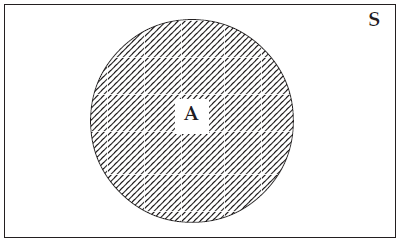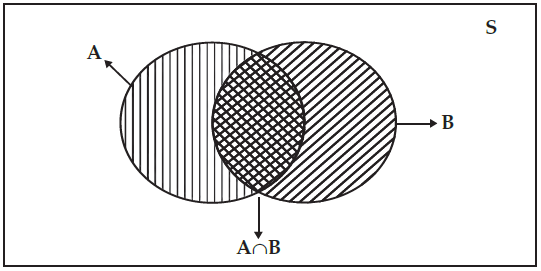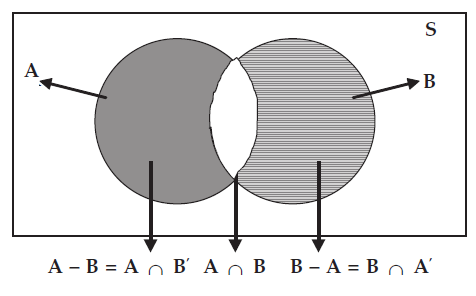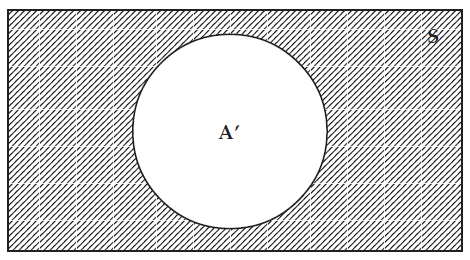OPERATION OF EVENTS IN PROBABILITY
Subscribe to our ▶️ YouTube channel 🔴 for the latest videos, updates, and tips.
Applying the concept of set theory, we can give a new dimension to the classical definition of probability.
A sample space may be defined as a non-empty set containing all the elementary events of a random experiment as sample points.
A sample space is denoted by S.
An event A may be defined as a non-empty subset of S. This is shown in the figure given below.

As for example, if a die is rolled once than the sample space is given by S = {1, 2, 3, 4, 5, 6}.
Next, if we define the events A, B and C such that
A = {x : x is an even no. of points in S}
B = {x : x is an odd no. of points in S}
C = {x : x is a multiple of 3 points in S}
Then, it is quite obvious that
A = {2, 4, 6}, B = {1, 3, 5} and C = {3, 6}
The classical definition of probability may be defined in the following way.
Let us consider a finite sample space S. That is, a sample space with a finite no. of sample points, n (S).
We assume that all these sample points are equally likely. If an event A which is a subset of S, contains n (A) sample points, then the probability of A is defined as the ratio of the number of sample points in A to the total number of sample points in S.
P(A) = n(A)/n(S)
Union and Intersection of Two Events
Union of two events A and B is defined as a set of events containing all the sample points of event A or event B or both the events. This is shown in the figure given below.
And we have
AnB = { x : x ∈ A on x ∈ B } where x denotes the sample points.
Showing the union of two events A and B and also their intersection

In the above example, we have
AUC = {2, 3, 4, 6} and AUB = {1, 2, 3, 4, 5, 6}
The intersection of two events A and B may be defined as the set containing all the sample points that are common to both the events A and B.
This is shown in the above figure. we have
AnB = { x : x∈A and x∈B }
In the above example, AnB = Null set
AnC = { 6 }
Since the intersection of the events A and B is a null set, it is obvious that A and B are mutually exclusive events as they cannot occur simultaneously.
Difference of Two Events
The difference of two events A and B, to be denoted by "A–B", may be defined as the set of sample points present in set A but not in B.
That is,
A - B = { x : x∊A and x∉B }
Similarly, B - A = { x : x∊B and x∉A }
In the above examples,
A - B = Null set and A - C = { 2, 4 }
This is shown in the figure given below.
Showing (A – B) and (B – A)

Complement of An Event
The complement of an event A may be defined as the difference between the sample space S and the event A.
A' = { x : x∊S and x∉A }
A' = S - A
A' = { 1, 3, 5 }
The figure given below depicts A'

Review
Now we are in a position to redefine some of the terms we have already discussed.
Two events A and B are mutually exclusive if
P (AnB) = 0
Or more precisely,
P(AuB) = P(A) + P(B)
Similarly three events A, B and C are mutually exclusive if
P(AuBuC) = P(A) + P(B) + P(C)
Two events A and B are exhaustive if
P(AuB) = 1
Similarly three events A, B and C are exhaustive if
P(AuBuC) = 1
Three events A, B and C are equally likely if
P(A) = P(B) = P(C)
Example
Question :
Three events A, B and C are mutually exclusive, exhaustive and equally likely.
What is the probably of the complementary event of A?
Solution :
Since A, B and C are mutually exclusive, we have
P(AuBuC) = P(A) + P(B) + P(C) ------ (1)
Since they are exhaustive,
P(AuBuC) = 1 ------ (2)
Since they are equally likely events,
P(A) = P(B) = P(C) = K, Say ------ (3)
Combining equations (1), (2) and (3), we have
1 = K + K + K
1 = 3K
1/3 = K
Thus P(A) = P(B) = P(C) = 1/3
Therefore, P(A') = 1 - P(A)
P(A') = 1 - 1/3
P(A') = 2/3
Subscribe to our ▶️ YouTube channel 🔴 for the latest videos, updates, and tips.
Kindly mail your feedback to v4formath@gmail.com
We always appreciate your feedback.
©All rights reserved. onlinemath4all.com
Recent Articles
-
SAT Math Practice
Dec 05, 25 04:04 AM
SAT Math Practice - Different Topics - Concept - Formulas - Example problems with step by step explanation -
10 Hard SAT Math Questions (Part - 37)
Dec 03, 25 07:02 AM
10 Hard SAT Math Questions (Part - 37) -
Factorial Problems and Solutions
Dec 02, 25 09:27 AM
Factorial Problems and Solutions

